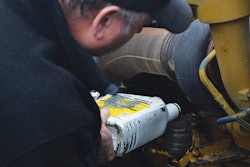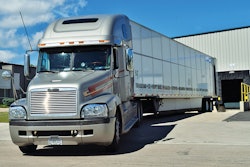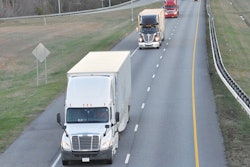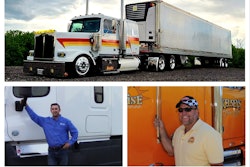PARTNERS IN BUSINESS TABLE OF CONTENTS »
Protect your career by following regulations, practicing safe driving and using data to your advantage
The 2015 debut of the Freightliner Inspiration, the industry’s first road-legal autonomous truck, raised many questions about its implications for where the industry is headed. Perhaps the biggest question for drivers concerns job security. For vehicles such as the Inspiration, operating at a moderate level of autonomy, a driver is required behind the wheel. When there is a need for changing lanes, parking or other circumstances that require common sense and quick judgment, the truck screams for help and turns control over to the driver. That driver needs the same level of driving experience as today’s owner-operators.
So there are many developments yet to come before we see a safe network of completely autonomous vehicles. These developments are needed in regulations, highway infrastructure and integration of autonomous technology in other vehicles. Even as these things evolve, technology will still require a driver behind the wheel.
TRUCK REGISTRATION
Before you legally can operate a commercial vehicle in interstate or intrastate commerce, you must comply with certain regulations. For the owner-operator, it starts with truck registration.

Independents are responsible for their own registrations. Leased owner-operators have the option of doing it themselves or letting the company they are leased to handle it. Generally, the company deducts the cost from the driver’s settlements. That might be easier, but if you get your plate through the carrier, you must leave it behind if you sever ties.
The cost of registering a truck varies from state to state, but you aren’t allowed to shop for the cheapest base state. To base-plate in a state, you must:
- Have an established place of business in that state, with a street address, a listed telephone number and at least one person conducting business at that location. A post office box is not sufficient.
- Maintain records in that location.
- Accrue miles in that state.
Before you can register, your base state will require you to pay the federal heavy-vehicle use tax. Also, if you don’t register your truck within 60 days of purchase, your base state will require proof of payment, usually a copy of Internal Revenue Service Form 2290 (heavy vehicle use tax return) and a canceled check.
Your truck must be registered in every state through which you travel. Years ago, you had to register separately in each state, but in 1991 Congress created the International Registration Plan, a streamlined nationwide system for truck registration.
Under IRP, you fill out a form and pay your base state. Similar to the way the International Fuel Tax Agreement apportions fuel taxes (see Chapter 5), a percentage of your fee goes to each state you travel through based on the number of miles you run in that state. When you register, you need to estimate how many miles you will travel in the coming year, state by state. Fees vary by each state.
SAFETY REGULATIONS
Most trucking safety laws are found in the Federal Motor Carrier Safety Regulations. Owner-operators must keep a copy of the regulations in their trucks. Many truck stops sell inexpensive paperback copies of them, and they’re also available online and in digital form via fmcsa.dot.gov.
The parts that most affect owner-operators include:
- Part 390. General overview: violations and penalties.
- Part 391. Driver qualifications: responsibilities, annual review, records, road tests.
- Part 392. Driving commercial motor vehicles: safe loading and fueling practices, safety at railroad crossings, seatbelt use, emergency signals, emergency equipment use, passengers, illness and fatigue, drug and alcohol use.
- Part 393. Parts and accessories: proper lights and reflectors, wiring, batteries, brakes, windows, fuel systems, coupling devices, towing methods, tires, sleeper berths, mirrors, defrosters, speedometers, exhaust systems, floors, rear-impact guards, frames, cabs, suspensions, steering systems.
- Part 395. Hours of service: maximum driving time and on-duty time, record of duty status, electronic logging devices, out-of-service declarations.
- Part 396. Inspection, repair and maintenance, including recordkeeping requirements.
- Part 397. Transporting hazardous materials, state and local laws, driver presence and surveillance, parking, fires, smoking, fueling, tires and routing.
In 2010, the Federal Motor Carrier Safety Administration began implementing its Compliance, Safety, Accountability program. It features a safety rating system for motor carriers, including independent owner-operators, based on roadside inspection observations and crash data.
The FAST Act highway bill, passed in December 2015, required FMCSA to remove CSA scores and its Behavioral Analysis and Safety Improvement Categories from public view until reforms are made to the system. However, scores remain available for viewing by law enforcement and motor carriers themselves. The general public and shipper/broker customers still can access raw inspection and violation data for any carrier going back two years. After the scores were pulled from public view, about a third of Overdrive readers still reported a third party (such as a broker, shipper or insurance company) requested visibility into their now-private scores as a condition of doing business.
Your carrier’s scores are affected directly by all of your on-road infractions noted by an inspector or safety officer. FMCSA has deployed a similar system that tracks individual driver performance internally the same way it is ranking motor carriers. The agency made intentions in the past to take this system public to rank individual drivers. This system is available in part to carriers checking your business’ history for pre-lease screening.
You can minimize the impact of CSA by being certain your truck is in compliance with all equipment regulations and by following these steps:
• Do everything practical to avoid inspection violations. That starts with thorough pre-trip and post-trip inspections and attention to needed maintenance, and extends to minimizing inspections themselves. Some carriers have instituted cash awards to operators for inspections with no violations, which help a carrier’s CSA rankings, so this could pay extra dividends. Use PrePass or other weigh-station bypass systems to stay out of the inspection stations as much as possible. Wash your truck regularly, dress neatly and otherwise avoid doing anything that might draw the attention of patrol officers.
Highway patrolmen note that up to 90 percent of every carrier’s problems arise from speeding. Slowing down will help your carrier’s or your own ranking, because if you speed and are caught, the officer often will inspect your vehicle, and small violations can mount up.
Clean inspections are the only immediate way to improve categorical percentile rankings in CSA’s Safety Measurement System. A clean Level I driver and truck inspection improves carrier scores in most SMS BASICs of compliance measurement by offsetting or diluting the weight of prior violations.
• Protect your MVR. If you get a ticket you believe is unjustified, whether following a crash incident or other violation on the road or at a scale house, know that payment of the fine is an admission of guilt. It ensures that the ticket becomes a conviction and will follow you through at least the next few years of your career — and in some states, much longer — on your Motor Vehicle Record.
Employers are required to keep on file an annual MVR for every CDL driver they employ. Depending on the carrier, one or more convictions for safety-serious violations could be grounds for terminating a lease.
The MVR is also a prime determining factor in insurance rates for all owner-operators.
If you think you’ve been ticketed wrongly, you can either represent yourself in traffic court or hire legal representation. Some services such as the Drivers Legal Plan (DriversLegalPlan.com) and Road Law (RoadLaw.net) represent truckers for generally small fees.
• Pick your partners wisely. A carrier that takes its safety scoring seriously is going to be increasingly more likely to have solid customers and its pick of freight than the opposite. Treat your carrier as a partner in your business, and look for them to treat you the same way.
• Learn to work with electronic logs. Since Dec. 18, 2017, when FMCSA’s electronic logging device mandate went into effect, drivers have been required to use ELDs for hours of service recordkeeping, with a few exceptions. The mandate does not apply to drivers of pre-2000 model-year vehicles or vehicles with pre-2000 model-year engines.
ELDs can eliminate the majority of what used to be common errors – so-called “form and manner” hours of service violations. Hours of service is one of seven BASICs in the CSA system.
Yet ELDs, by virtue of their partially automated, detailed recordkeeping, can create new compliance problems in difficult situations, such as when you are unable to find a place to park or need to move your truck a very short distance during an off-duty period. Be sure to stay current with regulators’ interpretations of personal conveyance guidelines and, if you’re leased, your carrier’s policy regarding ELD annotations and editing.
• Consider using video systems. A video-based driver risk management system can help determine fault in an accident. A forward-facing camera can prove a driver’s innocence in an accident and other events, key in making challenges to erroneous violations and in some instances contesting tickets to protect your MVR. Some fleets are using driver-facing cameras not only to determine the possible cause of an accident but also as an ongoing training tool. (Such systems usually are offered as opt-ins for leased owner-operators.)
• Mind the small stuff. Pay strict attention to all aspects of your operation. A frequently incurred violation contributing to scores in the Unsafe Driving BASIC is the simple seatbelt violation, often accrued after a speeding stop.
• Build law enforcement relationships. For independents, good relationships with the highway patrol in your area will enable you to call on them for advice in particular situations. It also will increase the possibility that, should you need help in the Vehicle Maintenance BASIC, they might make themselves available for terminal inspections, conducted at your central place of business.
Managing the historical inspection information that is being collected about you also is important.
• Access your records. In the view of FMCSA, any owner-operator who is leased to a carrier and who hasn’t had his authority for the last two years does not have any safety ranking in the CSA SMS. But a leased owner-operator’s data profile there is important. Leased owner-operators can gain access to the data the internal measurement is based on via FMCSA’s Pre-Employment Screening Program or PSP (www.psp.fmcsa.dot.gov) for $10.
Alternatively, making a Privacy Act request via FMCSA’s Freedom of Information Act office will net you the same results for free – but with a turnaround time of several weeks. If you have a prior driving and inspection history and haven’t accessed the information yet, it’s important to do so to make certain it is correct. It will be used by carriers evaluating any lease application you make, and it could impact your insurance rates.
For owner-operators applying for a new lease and facing carrier qualifying processes, a pristine PSP report is valuable, as some carriers look to tie driver mileage or percentage pay scales to safety performance. Providing an up-to-date clean PSP to a prospective carrier before they request such is something an owner-operator confident in his/her safety performance might do to document safety performance history effectively.
Whether you’re leased or independent, you’ll be reviewing information contained within the same database. Make certain all violations and/or crashes contained on your PSP, or in your CSA SMS profile if you have your authority, are connected to you correctly.
For independents, challenging erroneously assigned inspections or crashes, or violations tied to citations thrown out in a court of law, is your responsibility.
Challenges are conducted via FMCSA’s DataQs portal at dataqs.fmcsa.dot.gov. The Owner-Operator Independent Drivers Association offers its members free assistance with navigating this process, as do some ELD vendors and other service providers.
Download the entire Partners in Business Manual
Chapter 1: Becoming your own boss
Chapter 2: Bookkeeping and business analysis
Chapter 3: Understanding your revenue and costs
Chapter 5: Controlling fuel costs
Chapter 6: Controlling tire costs
Chapter 8: Income tax and other taxes
Chapter 9: Choosing a business structure
Chapter 10: Truck buying, leasing, financing
Chapter 11: Choosing a trailer
Chapter 12: Maintaining your equipment
Chapter 13: Choosing a carrier
Chapter 14: Computers, mobile devices and the internet
Chapter 15: Staying compliant and safe
Chapter 16: Trucking insurance













